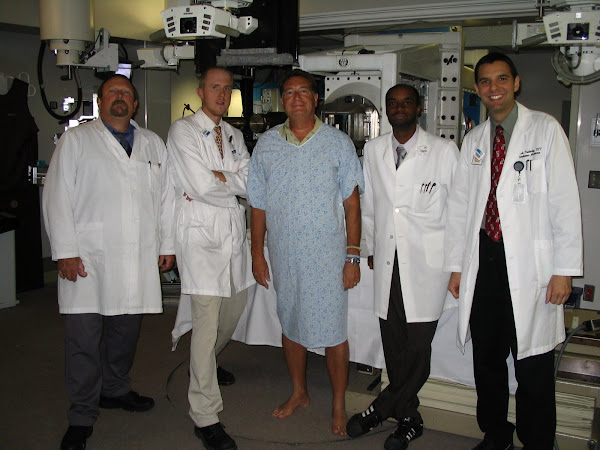Prostate Cancer Treatment Options
Prostate cancer that has spread may be treated with drugs to reduce testosterone levels, surgery to remove the testes, or chemotherapy.
Surgery, radiation therapy, and hormonal therapy can interfere with sexual desire or performance on either a temporary or permanent basis. Discuss your concerns with your health care provider.
SURGERY
Surgery is usually only recommended after a thorough evaluation and discussion of all treatment options. A man considering surgery should be aware of the benefits and risks of the procedure.
- Surgery to remove the prostate gland is often recommended for treating stages A and B prostate cancers. This is a lengthy procedure and complications are possible. There are many different surgery options. See: Radical prostatectomy and Robotic surgery.
- Orchiectomy alters hormone production and may be recommended for cancer that has spread to other areas of the body. There may be some bruising and swelling right after surgery, but this will gradually go away. The loss of testosterone production may lead to problems with sexual function, osteoporosis (thinning of the bones), and loss of muscle mass.
Radiation therapy is used primarily to treat stage A, B, or C prostate cancers. Whether radiation is as good as prostate removal is unclear. The decision about which treatment to choose can be difficult. In patients whose health makes surgery too risky, radiation therapy is often the preferred alternative. Radiation therapy to the prostate gland is either external or internal:
- External beam radiation therapy is done in a radiation oncology center by specially trained radiation oncologists, usually on an outpatient basis. Before treatment, a therapist will mark the part of the body that is to be treated with a special pen. The radiation is delivered to the prostate gland using a device that looks like a normal x-ray machine. The treatment itself is generally painless. Side effects may include impotence, incontinence, appetite loss, fatigue, skin reactions such as redness and irritation, rectal burning or injury, diarrhea, inflamed bladder (cystitis), and blood in urine. External beam radiation therapy is usually done 5 days a week for 6 - 8 weeks.
- Prostate brachytherapy or internal radiation involves placing radioactive seeds inside you, directly into the prostate. A surgeon inserts small needles through the skin behind your scrotum to inject the seeds. The seeds are so small that you don't feel them. They can be temporary or permanent. Because internal radiation therapy is directed to the prostate, it reduces damage to the tissues around the prostate. Prostate brachytherapy may be given for early, slow-growing prostate cancers. It also may be given with external beam radiation therapy for some patients with more advanced cancer. Side effects may include pain, swelling or bruising in your penis or scrotum, red-brown urine or semen, impotence, incontinence, and diarrhea.
- Radiation is sometimes used for pain relief when cancer has spread to the bone.
Cyberknife
The CyberKnife is a frameless robotic radiosurgery system. It produces radiation using a small linear particle accelerator and has a robotic arm that allows the energy to be directed at any
part of the body from any direction. By increasing the accuracy of the delivery of radiation, there is a potential for dose escalation, resulting in an increase in effectiveness.
The CyberKnife system has been approved by the US Food and Drug Administration to treat any solid tumor, including tumors of the prostate. Studies of the CyberKnife have not shown any general survival benefit over conventional treatment methods. Studies to date have been limited in scope, and more extensive research will be needed to show any effects on survival.
Proton Therapy
The CyberKnife is a frameless robotic radiosurgery system. It produces radiation using a small linear particle accelerator and has a robotic arm that allows the energy to be directed at any
part of the body from any direction. By increasing the accuracy of the delivery of radiation, there is a potential for dose escalation, resulting in an increase in effectiveness.
The CyberKnife system has been approved by the US Food and Drug Administration to treat any solid tumor, including tumors of the prostate. Studies of the CyberKnife have not shown any general survival benefit over conventional treatment methods. Studies to date have been limited in scope, and more extensive research will be needed to show any effects on survival.
Proton Therapy
Proton therapy is a type of radiation therapy in which doctors use positively charged radioactive particles to treat prostate cancer. Understanding proton therapy radiation treatment for prostate cancer involves learning the benefits of proton therapy as well as understanding how it differs from traditional radiation therapies.
- Because protons target and kill the DNA of a cell, doctors began using proton beams to treat cancerous tumors, where "rogue" cells multiply and grow at an abnormal rate. The charged particles in a proton beam kill the cancer cells at the DNA level, stopping growth and ultimately stopping the cancer. The relatively large mass of a proton due to the bragg peak means that there is little scatter from firing a beam of them at a specific target--which means doctors have a more exact, focused tool to target cancer cells than other types of radiation
therapy .
- The biggest difference between proton therapy and other, more traditional types of radiation therapy is the lack of damage to surrounding tissues. Because proton beams are very focused, doctors can use higher dosages of radiation with the confidence that stray radiation will not affect surrounding organs or tissues, such as the bladder or the rectum. The delivery method--using a particle accelerator to supercharge the protons and then using magnets to aim them into the patient's body--is another difference. A third major difference is side effects. With no radiation scatter to nearby tissues, patients usually do not experience the exhaustion, soreness or nausea that traditional therapies cause. Although some patients experience some warmth or redness, proton therapy has few side effects.
- The primary benefit of proton therapy is accuracy: Doctors have in a proton beam a much more exact tool to treat prostate cancer. Because of the focused approach, doctors can also use a higher dose of radiation to kill the cancer without risk to surrounding tissues, such as the rectum or bladder. Proton therapy is non-invasive (meaning no cutting of the body is necessary), painless and has a very low risk of side effects. Treatments take place on an outpatient basis, lasting around two minutes per session over several weeks. Proton therapy does not affect a patient's energy levels and requires no recovery time.
How It Works
How It Differs From Other Radiation Therapies
Benefits of Proton Therapy
Transrectal HIFUHIFU, which stands for High Intensity Focused Ultrasound, was first developed as a treatment of benign prostatic hyperplasia (BPH) and now is also being used as a procedure for the killing of prostate cancer cells. As shown in Figure 1, this procedure utilizes transrectal ultrasound that is highly focused into a small area, creating intense heat of 80-100° C, which is lethal to prostate cancer tissue. Since ultrasound is non-ionizing (as opposed to ionizing in radiation), tissue in the entry and exit path of the HIFU beam is not injured.
The published clinical experience with HIFU for this application is limited and only extends out to 5 years, and the procedure is not yet approved by the FDA for use in the United States, (HIFU is approved in Europe, China, Japan, Caribbean, Mexico, and Latin America). However, HIFU offers a powerful advantage over radiation treatment: The control and precision of HIFU allow the accomplished surgeon to accurately target the tissue to be destroyed without injuring adjacent tissue. HIFU destroys tissue by heat, rather than by cavitation or mechanical shearing forces.
Risks and Complications
Immediately after surgery, there will be urinary retention, because the gland will swell. Often, there will be necrosis (slough) of some or all of the urethra. Many patients pass this tissue without any problems, and others may require the removal of the tissue through a cystoscope (TURP). (Sloughing can also occur with cryosurgery, especially in radiation failure. Radiation necrosis of the urethra has been seen with brachytherapy, but no surgery is performed due to the high risk of problems in radiated tissue and the seeds.) Source PCRI
MEDICATIONS
Medicines can be used to adjust the levels of testosterone. This is called hormonal manipulation. Because prostate tumors rePost Optionsquire testosterone to grow, reducing the testosterone level often works very well at preventing further growth and spread of the cancer. Hormone manipulation is mainly used to relieve symptoms in men whose cancer has spread. It may also be done by surgically removing the testes.
The drugs Lupron and Zoladex are also being used to treat advanced prostate cancer. These medicines block the production of testosterone. The procedure is often called chemical castration, because it has the same result as surgical removal of the testes. However, unlike surgery, it is reversible. The drugs must be given by injection, usually every 3 - 6 months. Possible side effects include nausea and vomiting, hot flashes, anemia, lethargy, osteoporosis, reduced sexual desire, and impotence.
Other medications used for hormonal therapy include androgen-blocking drugs (such as flutamide), which prevent testosterone from attaching to prostate cells. Possible side effects include erectile dysfunction, loss of sexual desire, liver problems, diarrhea, and enlarged breasts.
Chemotherapy is often used to treat prostate cancers that are resistant to hormonal treatments. An oncology specialist will usually recommend a single drug or a combination of drugs. Chemotherapy medications that may be used to treat prostate cancer include:
- Adriamycin
- Docetaxel
- Estramustine
- Mitoxantrone
- Paclitaxel
- Prednisone
- Blood clots
- Bruising
- Dry skin
- Fatigue
- Fluid retention
- Hair loss
- Lowering of your white cells, red cells, or platelets
- Mouth sores
- Nausea
- Tingling or numbness in hands and feet
- Upset stomach
- Weight gain
You will be closely watched to make sure the cancer does not spread. This involves routine doctor check-ups. Monitoring may include:
- Serial PSA blood test (usually every 3 months to 1 year)
- Bone scan or CT scan to check whether the cancer has spread
- Complete blood count (CBC) to monitor for signs and symptoms of anemia
- Monitoring for other signs and symptoms, such as fatigue, weight loss, increased pain, decreased bowel and bladder function, and weakness











